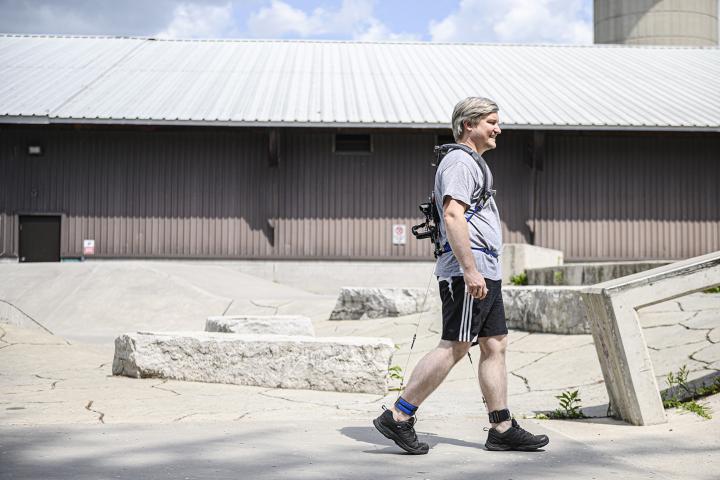The pandemic-driven explosion in virtual health service has left many patients – especially older people – struggling in a brave new digital world. Queen’s University researchers have developed a unique toolkit to empower patients to navigate their remote appointments and improve care.
Patients played an integral role in shaping the new online resource, which includes how-to videos, technology tips, and guides for patients/caregivers. In fact, it was a patient who planted the seed of the concept in the mind of Dr. Ramana Appireddy, a Queen’s assistant professor in the Departments of Medicine and Public Health Sciences.
It was winter 2018 and the neurologist was working at the Kingston Health Sciences Centre’s (KHSC) stroke clinic. During a routine check-up with an elderly patient, he learned about the herculean effort she faced just to be in the same room with him for a few minutes. For starters, she lived in a remote, rural home far from Kingston. Not only had she required snow to be removed from her nearly one-kilometre-long driveway, but she’d hired a driver to transport her to-and-from the city.
“There should be a better way to do this,” Dr. Appireddy remembers thinking about such follow-up appointments, which are often short interactions to go over things like simple test results or quickly review medication. “It turns out, there was.”
Dr. Appireddy started one of the first virtual stroke prevention clinics in Ontario at KHSC later in 2018. “But we soon came to a realization,” he explains. “Patients love the convenience of virtual appointments, but there were not a lot of resources available. They just need some more education, awareness, and understanding about how to do this.”
To connect the dots, Dr. Appireddy and his research team needed patient collaborators. Lots of them. They interviewed more than 120 patients, caregivers, and family members, and conducted a national survey. This early examination of digital literacy around virtual care felt prescient when COVID-19 emerged in early 2020.
“Our whole system was built on the in-person model of care,” explains Dr. Appireddy. “The rapid introduction and widespread adoption of virtual care created issues. All the players needed to understand how it worked and how to participate in this model.”
That need attracted partners from across the health-care sector. The project was co-funded by the Canadian Institutes of Health Research, Canada Health Infoway, Kingston General Health Research Institute, KHSC, and Queen’s Health Sciences.
At best, most health-care providers may offer a virtual app-ointment brochure or brief online instructions, but Dr. Appireddy’s team wanted to develop a comprehensive resource that could help improve any remote-patient experience – regardless of the medical need, institution, or digital platform.
Some key takeaways emerged from their consultations: patients and caregivers wanted choice (whether video, telehealth or in-person care), and – most importantly – they wanted detailed information on how to engage in virtual care safely, securely, and well-prepared.
“Patient engagement ensures the end products will be relevant and needed in health-care today,” says Anne O’Riordan, a patient-partner on the project, part of KHSC’s Patient and Family Advisory Council, and a retired Queen’s faculty member.
The team focused on meeting the real needs of patients and families, she adds. Their Virtual Care Access Toolkit (VCAT) was completed in 2020 and debuted online for patients at the KHSC this past fall. It includes videos and guides on subjects like “Is virtual care right for my current medical condition?” and “How to prepare for a virtual care appointment”.
The toolkit is especially beneficial to older Canadians who may lack digital skills and experience. “Many don’t have a fundamental understanding of how to interact with a health-care provider by video, by email, or by phone,” Dr. Appireddy explains. “This is something they haven’t done for 70 or 80 years of their lives.”
The toolkit is open access, AODA- compliant, and incorporates Equity, Diversity, and Inclusion principles – thanks to a collaboration with Queen’s University’s Human Rights and Equity Office. It is available in both English and French, and the team hopes to translate it into at least three more languages common in Canada.
But their work is far from over. Their research is slated for publication in the Canadian Medical Association Journal Open this year and a toolkit module for health-care providers will be available in April 2022.
They also hope to attract funding to continue a new round of research on the effectiveness of their toolkit. Continuous quality improvement is their goal – not to mention reaching more patients and caregivers by adding more Kingston partners, and then expanding their reach provincially and nationally. And they want to customize their toolkit for different patient populations.
For now, Dr. Appireddy hopes their early work makes the health-care system more effective. The toolkit could be a game-changer for the average medical clinic. Dr. Appireddy estimates many locations take on dozens of new virtual appointments bookings in a day – with no staff resource available to educate patients on what comes next and how to prepare.
“COVID-19 rapidly transformed the amount of virtual health care in all of our lives,” Dr. Appireddy says. “We were fortunate to have a bit of a head start.”
By leading the pack, his team’s collaborative research could improve the patients’ virtual health-care-experiences far and wide.


